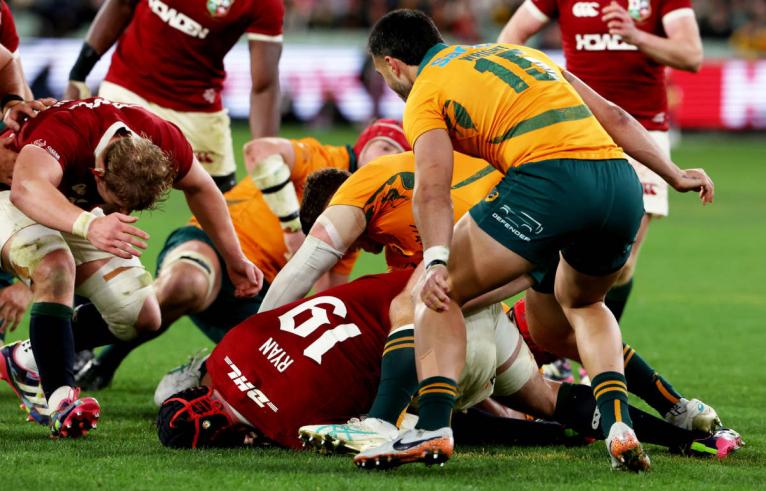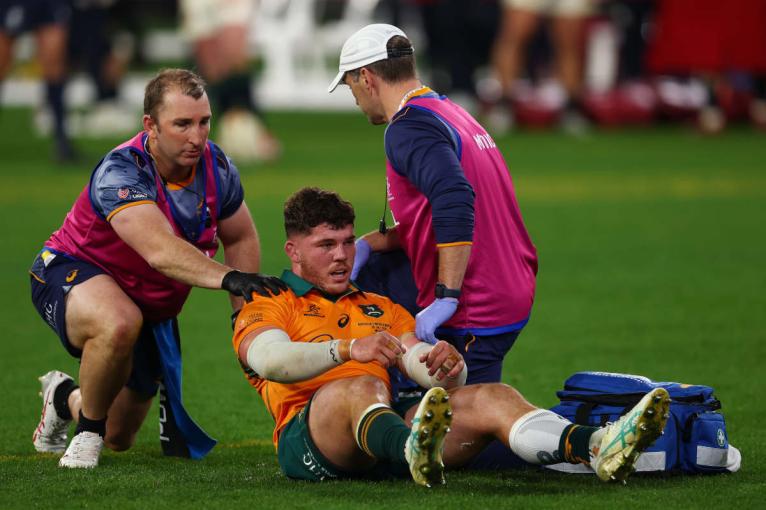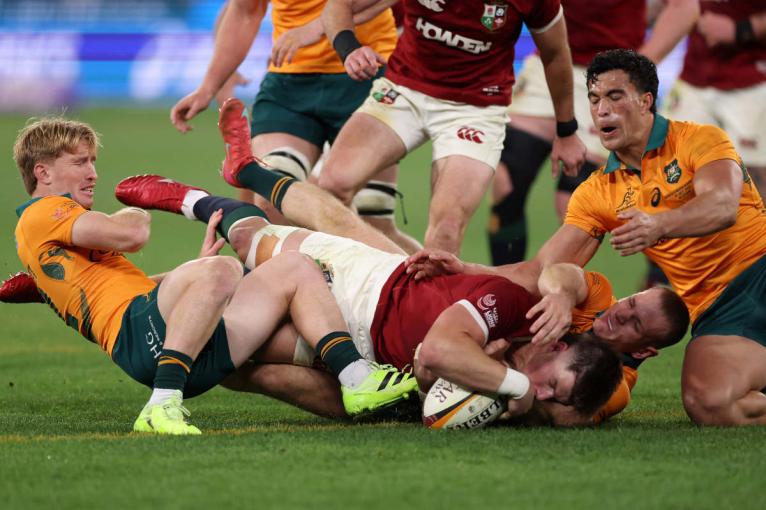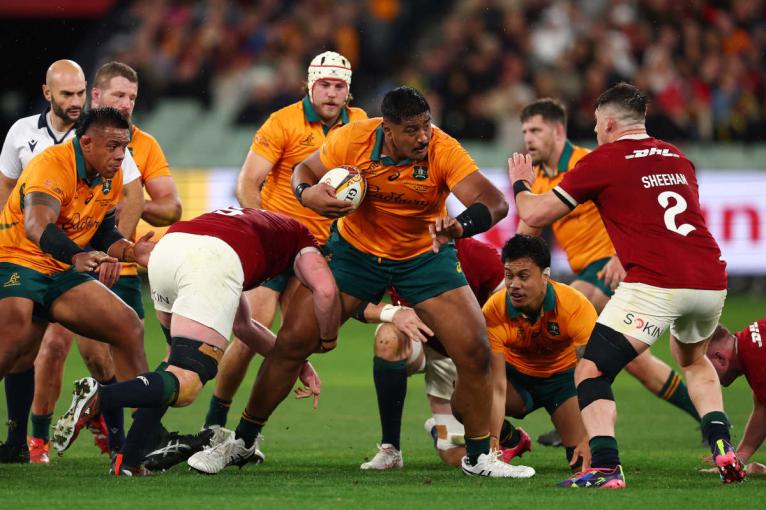For everyone out there in the rugby world trying to console Australians with well-meaning offerings like ‘you’ve got to go through something like that to get better’ or ‘you need the heartbreak to truly appreciate the success’, I have only one thing to say to you.
You better be bloody right.
The average Wallabies fan wants nothing more than a return to the glory years of the late 90s-early 2000s and has had to go through more heartbreak in the last decade alone than any fan should have to. Somehow, as if it even needed to be possible, Saturday’s Second Test result against the Lions seems to have trumped all the terrible, terrible feelings we’ve endured in that time.
To be fair, the playing group and coaches would have been, and might still be, in the same grumpy head space as the fans. They did all the preparations and training, developed and rehearsed the game plan, played it all out mentally to be ready for whatever the game threw at them. The heartbreak was very clear in Harry Wilson’s immediate on-pitch reaction to the result. He was – they all were – feeling the pain as well.

Which brings us onto this week’s Third Test, and how the Wallabies bounce back from the heartbreak. They have one last opportunity to salvage some degree of pride from this series, and the motivation of wanting to avoid a first Lions sweep of the professional era will be significant.
There are most certainly lessons to learn from Melbourne.
Tizzano’s picture wasn’t quite clear enough
Carlo Tizzano might still be wondering what more he had to do to win another important ruck penalty, but he would also know by now the picture he presented Italian referee Andrea Piardi just wasn’t good enough in that moment.
Whether he came in from the side is still debatable, and the still-shots and screen-grabs certainly show that he beat Jac Morgan to the ball – even if only by a fraction of a second – before the Welshman blasted him out with the cleanout that will be dissected right up until kick-off in Sydney this weekend.
But there were still two problems for Tizzano here, when all was said and done.
Maybe Tizzano was too quick for the human eye in that moment, but superpower or not, his actions hadn’t ticked all the boxes.
The first was that rightly or wrongly, Piardi was immediately, and remained, of the view that both players arrived simultaneously. Whether that was accurate or not is immaterial, but it was the base from which all decision-making of the incident was made.
The second was that Tizzano never really got a clear lift on the ball before Morgan arrived. His hands were on the ball, certainly, and you could definitely make the argument he’d won the rights to the pilfer. But Piardi never saw a clear lift – or a clear enough lift – which when combined with his belief the two players arrived at the same time, explains how he reached the conclusion that this now was just a rugby incident of the sort which happens all over the field in pretty much every game.

Maybe Tizzano was too quick for the human eye in that moment, but superpower or not, his actions hadn’t ticked all the boxes. If that lift is visible enough, then the two players can’t have arrived simultaneously, and the pilfer is probably rewarded.
Piardi – who I thought had a strong game – had rarely rewarded the on-ballers all night, so this non-decision for Tizzano was very much in line with the previous 79 minutes.
But here’s why I’ve kept oscillating on this decision in the days since.
We saw a high contact yellow card in the First Nations & Pasifika game a week ago that during the review process was walked back to “indirect contact” according to the match TMO – meaning it arguably shouldn’t have been a card at all.
Through that lens, are we really saying Morgan’s direct contact on Tizzano’s shoulder and neck area didn’t even warrant a penalty?
I’m still undecided on the whole thing as a result. Tizzano will have thought he’d done everything right. Morgan probably won’t care now, but would argue he produced what plenty of coaches would and did call a textbook cleanout.

Piardi would still be seeing the simultaneous arrival, and even Joe Schmidt’s point about contact above the line of the shoulders is valid. They can’t all be in the right, but somehow, quite incredibly, in this instance they are!
It just comes back to the picture presented. And unfortunately for the Wallabies and all the fans still processing that last play, the picture just wasn’t quite clear enough.
No lead was ever going to be safe
The Wallabies, having come back from 24-5 down in Brisbane just a week earlier themselves, would have known their own superbly crafted 23-5 lead in Melbourne was always going to be challenged. The two tries and 12 points they added while Tommy Freeman was off with his yellow card came on the back of 90% possession in that 10-minute period and simply had to even out.
The Lions were always coming back. So the defence in the five minutes before half-time – while leading by 18 – had to be rock solid, and it just wasn’t.
This was the first time in Australia that the Lions had trailed at half-time, the first time they were forced to chase a game the whole way, and the Wallabies simply were not good enough to hold them out.
Twice the Lions were able to advance deep into the Wallabies red zone in those five minutes, and twice they set themselves up to exploit weaknesses in the Australian defence.
This is where the counter-argument about where the Wallabies really lost the game has merit. If they’d been able to go into the sheds leading 23-5, or even only 23-10, the conversations and the messages are a whole lot different to when the score read 23-17.
This was the first time in Australia that the Lions had trailed at half-time, the first time they were forced to chase a game the whole way, and the Wallabies simply were not good enough to hold them out.
That’s a huge lesson with South Africa and New Zealand now less than a month away.
The defence remains too passive and confused
From a Tom Lynagh knock-on and resultant scrum win, the Lions were able to launch an attacking wave from well outside the Wallabies 22 that got all the way to the five-metre line, from where the Lions reset and got into their pick-and-drive to the right of the posts.
But instead of switching to the left, Jamison Gibson-Park went back to the right, where somehow Jack Conan and Tom Curry had managed to create an overlap despite being marked by Lynagh and Max Jorgensen. When the two young Wallabies bit in too hard, Jake Gordon’s cover was never going to stop Curry getting to the corner.
Australia then gave away a ruck penalty in the Lions half, which Finn Russell converted into a lineout no more than eight metres from the hosts’ try line. An uncontested lineout and four or five strong carries put them within reach earlier than expected, and from there, Huw Jones was able to get through two shoulders to score next to the right post.

The two shoulders belonged to Wallabies wingers Jorgensen and Tate McDermott, who even allowing for one winger to be well in-field in a compressed defensive set-up, shouldn’t have both been in that same two square metres of turf. Jones couldn’t believe his luck, and the Lions went into the sheds thinking, ‘well, that was easy’.
Those five minutes before half-time was the worst of the Wallabies defence for the night. Way too passive, ill-disciplined, and often caught a long way out of position. It can’t continue.
You can go to the bench too early
We’ve since learned that tighthead Allan Ala’alatoa has picked up a pectoral injury, and Rob Valetini’s troublesome calf had tightened to a point that both had to be replaced at half-time and remain in doubt for the Third Test.
But did James Slipper need to come off then as well? And Will Skelton only seven minutes into the second half?
The Wallabies scrum in the first half had been holding up but immediately went backwards, with the feeling of the bench being cleared unnecessarily early, and thus allowing the Lions’ starting pack to add set-piece ascendancy to their growing momentum.

By contrast, Andy Farrell waited until the 54th minute to send on the first of his forward replacements and didn’t have an all-new front row until 10 minutes later, by which time the margin was just two points.
It was well thought out, deliberately strategic, and perfectly timed finishing.
So what now?
How the Wallabies react to the MCG loss will be illustrative of this playing group, and potentially, can set them up for the rest of the 2025 international season.
There may be no better preparation for The Rugby Championship featuring the top two teams in the world than to take on the best of whatever England, Ireland, Scotland and Jac Morgan can throw at them.
And there is no doubt this Wallabies side is much better than where the general expectations and bookies’ odds had them pegged. It’s up to them now to determine how they translate this current pain into longer term success.
Because I sure know that we fans can’t handle too much more heartbreak like Saturday.
News, stats, videos and more! Download the new RugbyPass app, in collaboration with the British and Irish Lions, on the App Store (iOS) and Google Play (Android) now!



Brett I love your fresh take on the picture that needed to be painted and ultimately wasnt. I agree there just wasnt enough in it for the ref to call it back and ultimately the ref was consistent the whole night at the breakdown. Australia are damned disheartened now but look how close it came to beating a team Campo said would thrash them by 30. This is the perfect prep for the Rugby Championship and the Boks and NZ. The Boks will be able to bring a scary pack to face the Aussies but it will be just as scary as facing these lads and so the Wallabies for me are making progress. They are not quite the finished article and the soft moments and tries and passive defence just proves it. Schmidt was brought in to make Australia better, he was brought in to make sure Australia improved in time for the Lions to avoid an embarrassment and look he has done that and taken them close so while the result is gutting its a job well done so far. lets see if they can take one step further and pilfer a test off these patchy Lions. Just a quick word on refs and the laws. Can we please tell World Rugby to simplify the game. At least 5 or 6 laws were examined in the wake of the last minute cleanout and several said Tizzano should have been pinged, others say Morgan should have been pinged. If former players and refs cant agree on what the right call was then it means the game is too complex. The refs have a clear mandate to let the game flow. I agree with that but the laws must support the refs. Right now they do not and leave too many holes for the refs to plug. The result is a furore after every major engagement between nations where the refs are abused.
The main issue is that Schmidt messed up on selections. The best performers in the trials were Gamble, Amatesero, Loto (and Samu should be there based on his form for UBB), the entire First Nations front row should also be in in place of Slipper, Robertson, and one of the hookers. Wilson and McReight need to go as they have been ineffective in busting the line and jackling respectively cf Loto and Gamble. Amatesero has more impact in maul defence and carries than the other locks save Skelton and Frost. He should be there.
The lack of power is the main problem but the players are there.
Cheers for the article Brett, lots to think about, but that first half was probably the best 30 minutes of Wallabies rugby we’ve seen in a long time. That shouldn’t be forgotten.
The next 50 however….
Has anyone figured out why Schmidt left McDermott on the wing and didn’t use Donaldson to rearrange the backline? Has he clarified it?
It’s perplexing, AUS had 0 impetus on attack the whole second half. Gordon looked out on his legs and was arriving slow after he played really well in the first half. He was just lining his forwards up to get smashed at one point.
It’s hard to see how we are benefiting from Fisher’s passive defensive. The Lions ran their backline plays with all the time they needed and we soaked and conceded 5 tries.
Gotta be more aggressive - we’re the last top side to do so and it’s failing us
On his ‘Off The Ruck’ YouTube channel, John Ferguson has 2 videos about the Wallabies defensive system. The first one is from the Fiji game, the 2nd is from the weekend.
With regards to the match in Melbourne, he’s suggesting defensive errors around player mistakes rather than the system itself.
Give me a system where opponents have their time and space cut down via aggressive line-speed rather than one which gives time and space, has defenders backpedalling and makes it difficult to own collision/contact area when the tackle is made.
Laurie Fisher can be valuable as a breakdown coach. However, with this defensive system, some Tonyball at Ellis Park and that game against the Boks will be grim.
Hi Brett, a win would achieve Lions first whitewash in 100 years (1927 Argentina). Wallabies do not want to be on the wrong side of that milestone forever.
Yes, that’s a pretty healthy motivating factor, PS
I wasn’t around in 1927 in BA to validate this, unlike MZ below.
I will make this observation on “Lions first whitewash in 100 years”, Ps. Had there been all the modern aids for the referee, including the TMO, the 1974 Lions would have clean swept the Springboks. In the 4th drawn test ay Ellis Park, Fergus Slattery went over for a try on the blindside from the referee.
He rightly did not award the try, as at that time the referee had to see the grounding. I make this observation as my brother and I were at that game, and had a clear view of Slattery going over.
I see the Tizzano/Morgan clash this way. First, Tizzano could not be penalised for incorrect entry, as when he went in, there was no ruck existing. His action made it a ruck. The Lion carrier laid the ball back well, and Tizzano never got near a lift.
Morgan did not come at speed from a distance, he was always close to the action, coming in a fraction after Tizzano. His cleanout was as good as it can ever be in that situation. I thought the contact was more on the back than the neck. That could easily lead to injury, but unlikely to be spinal cord. So I feel the officials decision was a fair one.
But on another day, another referee and TMO, the result could easily go the other way. Luck plays a big part in all games, wins, losses. Lions were lucky, WB’s were not, in this specific case. Sadly for us , that is the series gone.
Top comment on a good article Miz.
Ultimately Tizzano was not required to have an HIA, which is mandatory on the least suspicion of concussion or a head/neck injury.
And he’s available again this week, so you can draw your own conlcusions from that.
I keep thinking about the YC in the First Nations game Mizz, it’s certainly hard to reconcile the two and say that one is definitely worse than the other…
(speaking of another ref/TMO in another game)
A very fair and reasoned analysis. Thanks Mz.
A good analysis.
You need two players for a ruck. One player is not enough.
Similar to the Bok in field line-out. There’s no maul, the opposing player can get on the other side and wait for the ball.
On Tizzano, please check Rubiolo’s YC upgraded to red on the Pumas game against England, confirming your view of another game, ref, TMO…
I think that's a very reasonable assessment. I can see why some fans may think it should be a penalty but you see these sorts of collisions all the time. There really isn't much else Morgan could have done, it was a very dynamic situation, very low to the ground, he did everything he reasonably could do to clearout legally. It would have been harsh to overturn a try on this basis and would be setting a difficult precedent. I don't think you can start going back and overturning tries claiming incidents like this are foulplay. It's nearly impossible to avoid some minor head contact in that situation. So my view is that yes in some interpretations of the rules it could be a penalty but it's the sort of collision you see dozens of times per game only this time Tizzano made a meal of it.
Plenty to discuss here, Brett. Thanks for the article. That was a great game, and one that in the final analysis the Lions won, rather than Australia lost. And in reality, though this is not in my view one of the great Lions teams, it is still a very good team, and just has enough good players to have carried the day in this very close second test.
It isn't a great Lions team. Compared to the players they had between 2001 and 2005 with the likes of Brian O’Driscoll, Paul O’Connell, Martin Johnson, Johnny Wilkinson, Jason Robinson, Richard Hill, Phil Vickery, Andrew Sheridan, Shane Williams, Scott Gibbs etc. In terms of personnel they're just not at that level.
What they've got is a core of players from a good Irish team and an excellent coach. In spite of this they've still struggled for cohesion but have solid players from 1-15 and very accomplished halfbacks steering the ship. They've been ok. Any talk of them going down as the greatest Lions team in history if they win 3-0 is nonsense. I think the fact that so many of the starting team come from one nation implies they're not that great. Very few players from the other nations have put their hands up. Without really hurting the quality of the team you could replace most of the non-Irish players with their Irish counterparts - Curry by JVDF, Freeman by Hansen, Chessum by McCarthy, the centres by Aki and Ringrose. You're basically playing against a good but past their best Ireland team plus Itoje and Russell.
This lot aren’t a patch on the sides that won in New Zealand and South Africa in 1971 and 74 respectively.
23-5 becoming 23-17 due to Tommy Lynagh dropping a kick he probably should have caught and Sua’ali’i coming in from the side gave the tourists the impetus to believe they were going to win, a win which felt inevitable the longer the game went on.
I’m starting to strongly believe that Sua’ali’i needs to be in the back 3 until he improves defensively and understands the legalities at ruck time. Ray Charles saw the side entry he was penalised for. He painted a bad picture for the ref.
Laurie Fisher can be valuable as a breakdown coach but Australian rugby must explore whether a more aggressive, blitz/rush defence is the way forward.
Absolutely Mitch, watch how the lions react every time they see Sua’ali’i is the first man to the breakdown, they swamp him! No doubt he should be in the 23 but it seems like his immediate success at 13 last year was a misleading disservice and the lions have figured out his weaknesses now.
At 14/11 with a lot of license to roam like popping up in the midfield to make breaks would be interesting. Would get him under mor high balls too. It’s crazy he is having to play 15 at super and is then expected to learn the intricacies of 13 during test matches!
Has any league convert managed that?
It’s certainly an issue Mitch. The problem is, I don’t think dropping him back to fullback solves anything, in fact it may cause other problems (not to mention how well Tom Wright is currently playing, and has been for the last two years or more).
Right wing could be the spot, but it will need committment from NSW, too..
Yeah i rekon a rugby league country like Australia should employ those tactics in their backline. In attack and defense. This would make it easier for players to transfer back and forth between codes. Theres a wealth of quality league coaches the equal of Farrell in Australia
Good post, Mitch. Agree with all points. Def. Sua’ali’i is being exposed in the midfield atm. Big factor in WB’s defeats is fact we don’t have a true specialist at either 12 or 13. I feel a better bet at 12 would be Kerevi. I have not seen him play up in Japan recently, but read he is playing well. Paisami worth a go, as he did well in a weakened Qld. team against the Lions. Ikatau then out to 13, his specialist position.
He should always have started his career in the back three. Much higher success rate of converting league players into wingers than centres and he has phenomenal aerial ability. In a couple of years they can look to develop him into a 13 or 15. For now get that boy on the wing.